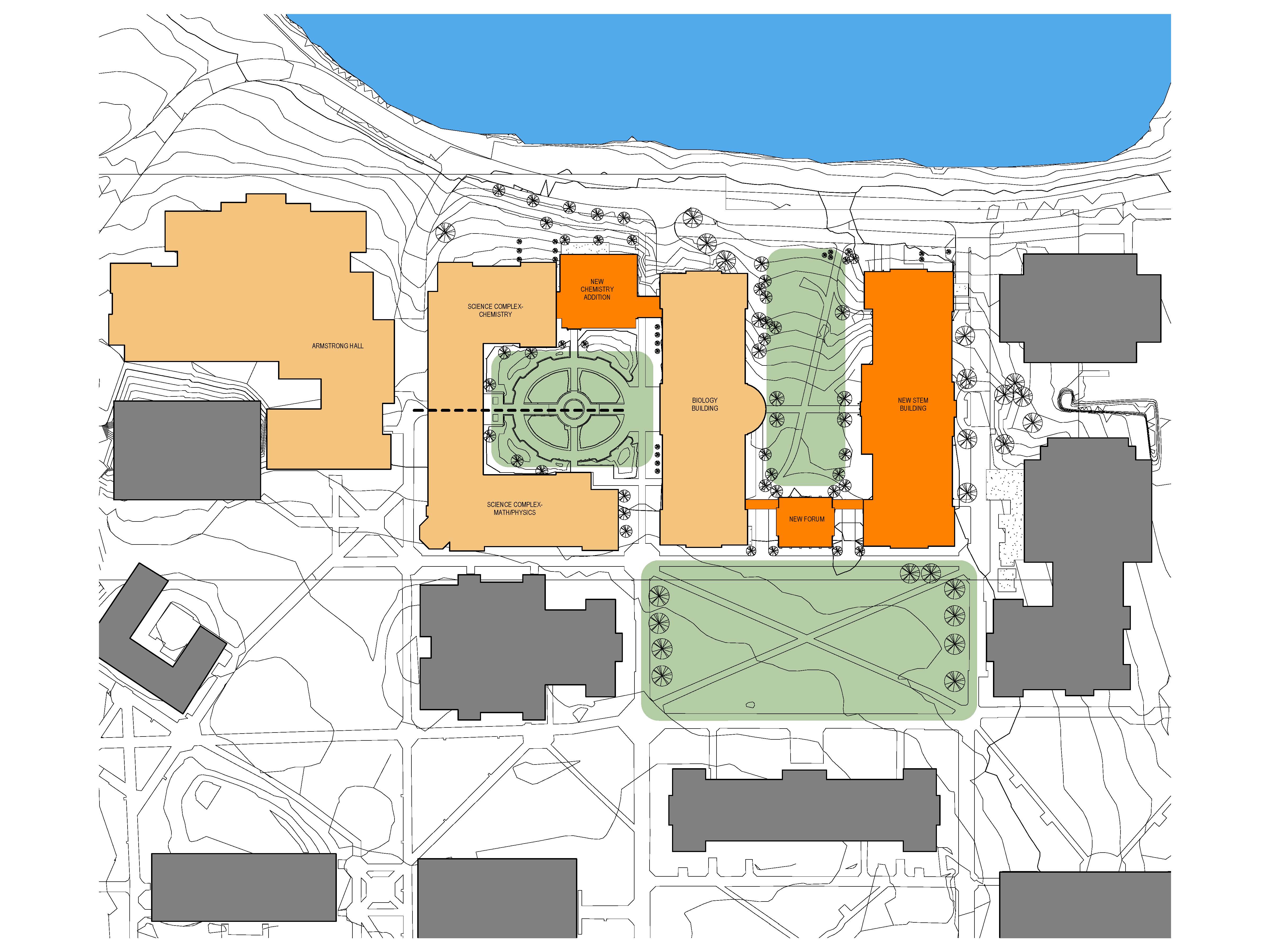Project Overview
Our Vision
To connect TCNJ students with the synergy and the tools—the how-it’s-done—of science, technology, engineering, and math (STEM) in the 21st Century. That’s the vision driving our ambitious $75 million STEM Complex project. First, we’ll remove the physical barriers that stand in the way of creativity and collaboration. Second, we’ll build knowledge-sharing spaces—from labs to lounges—that spur ideas and innovation. The result? Our graduates begin their careers fully integrated into the collaborative environments embraced by today’s innovators.
Project Scope
Phase 1 of our STEM Complex project includes the construction of the new STEM Building, Chemistry Addition, and Forum. Phase 2 includes renovations of our existing science buildings (Biology, Chemistry, Physics, and Mathematics Buildings). Phase 3 included renovations of our existing engineering building (Armstrong Hall).ƒ
STEM Building
The 89,000-square-foot STEM Building is the heart of this project. It houses the Department of Biomedical Engineering, the Department of Computer Science, and the Department of Mechanical Engineering.
The building has been designed from the ground up to facilitate a fresh, multifaceted approach to teaching and learning. Glass replaces walls. Interactive lounges supplant isolated hallways. Teaching and research occur across—rather than within—disciplines. By bringing students and faculty closer together, without barriers and across boundaries, we can prepare a new generation of TCNJ graduates for the demands of the STEM economy: creative thinkers who are comfortable working on teams and collaborating across disciplines.
Highlights include:
- The Computer Science Faculty-Student Collaborative Research Suite accommodates a wide array of research areas including computer imaging, networking and security, machine learning, grid computing and computational journalism, and human-computer interaction.
- The High-Performance Scientific Computing Cluster strings together approximately 300 servers, and provides a platform for the intensive computing needs of faculty and student researchers.
- The Robotics Laboratory is used for design, research, and teaching about a myriad of topics that span software algorithms and hardware design.
- The Biomedical Engineering Research Suite features biosafety level 2 facilities that allow for sophisticated experiments in support of research thrusts in areas such as neural engineering and prosthetics, tissue engineering, physiological control systems, and hemocompatibility.
- The Mechanical Engineering Design Studio enables students to fully develop their complex designs from concept through validation. Specialized spaces for prototyping, systems validation, material testing, and other advanced testing complement student and faculty research and design efforts.
- Many informal learning spaces, such as student commons and open study rooms, have also been strategically integrated into the building’s design.
Computer Science Renderings
Chemistry Addition
TCNJ’s Chemistry Department is poised to become one of the nation’s top undergraduate programs. It is in the top four percent in the US and first in New Jersey in the graduation of American Chemical Society-certified bachelor’s degree chemistry graduates. The 26,300-square-foot Chemistry Addition gives them the space and equipment they need to make the leap.
Highlights include:
- The Multidisciplinary Super Laboratory Suite allows for a seamless transition between computational, experimental, and analytical activities. A state-of-the-art instrumentation laboratory houses current and new equipment and it is outfitted with camera and screen-capturing technology to facilitate instrument usage and instruction. This lab, along with a specialized instrument lab and a laser facility, is interconnected with a computational chemistry laboratory, a synthetic chemistry laboratory, and a multipurpose chemistry laboratory.
- The Organic Chemistry Laboratory Suite, including two interconnected laboratories, and a unified prep lab, provides state-of-art pedagogical space and instrumentation for core chemistry courses that serve the entire campus.
- Informal learning spaces, including student commons, open study rooms, and closed study rooms, are integrated into the Chemistry Addition.
Forum
The glass-enclosed Forum connects the new STEM Building with the existing Biology Building, creating a unified interdisciplinary STEM Complex from the discipline-specific buildings that currently exist. A flexible two-story student commons with café, tables, and soft seating, it functions as a campus-wide “living room,” allowing for cross-disciplinary interaction in a casual, creative setting.
Total Project Cost
$75.368 million, $40 million of which is provided through the Building Our Future Bond. An additional $1.075 million in funding comes from the New Jersey Higher Education Technology Infrastructure Fund. The college funded the balance through a variety of sources, including philanthropy.
Note: Building Our Future Bond funding also supports a nursing simulation lab, which is housed in neighboring Forcina Hall.
Architects
TCNJ engaged EYP Architecture & Engineering for Phases 1 and 2 of the STEM Complex Project. EYP is an expertise-driven design firm nationally recognized for high-performance projects in the Corporate, Government, Higher Education, and Science & Technology sectors.
How to Give
- Visit “The Campaign for TCNJ” website
- Download flyer on What This Campaign Means to the School of Science
- Download the STEM Complex brochure – “The Promise of STEM Education”
- View the STEM Complex online flipbook – “The Promise of STEM Education”
News
- ‘We’re building on success here’: TCNJ breaks ground on $75M STEM building. By Cristina Rojas. NJ.com. July 7, 2015
- TCNJ creating new STEM complex. By Jonathan Lai. philly.com. July 7, 2015.
- STEM Facility Bridges Gap from Student to Scientist. By Jessica Burdg. Laboratory Equipment. August 12, 2015.
- The College of New Jersey celebrates new STEM complex. By Nora Muchanic, 6ABC News, Philadelphia. October 12, 2017.
- The College of New Jersey opens $76M STEM complex. By Olivia Rizzo, NJ.com, October 12, 2017.
- N.J.’s $750 million investment in colleges starts to pay off | Editorial. By the Times of Trenton Editorial Board. NJ.Com. October 16, 2017.
- New Jersey colleges invest in STEM with new facilities. NJ.com (NJ Education, Learning Curve). November 1, 2017.
- New $96 Million STEM Complex at The College of New Jersey Inspires Cross-Disciplinary Collaboration and Innovation. By Tracy Carbasho. Tradeline. June 26, 2019


























